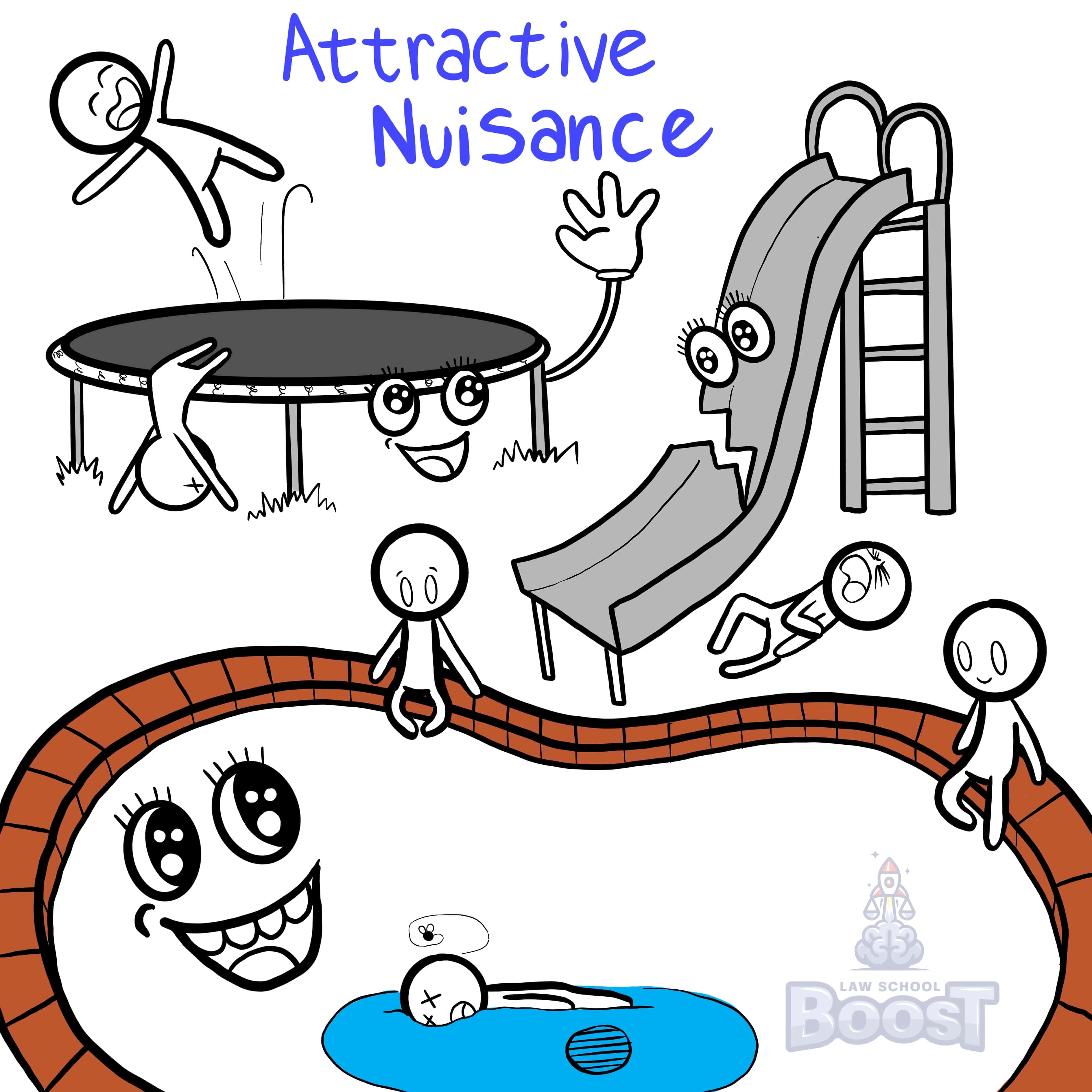👀
Torts • Negligence
TORT#043
Legal Definition
Landowners may be held liable for injuries to children trespassing on their land if the injury is caused by an object on the land that is likely to attract children.
A plaintiff must show that: (1) a dangerous condition on the land that the owner is—or should be—aware of; (2) the owner knows—or should know—children frequent the area; (3) the condition is likely to cause injury as a result of a child's inability to appreciate its risk; and (4) the expense of remedying the situation is small compared to the magnitude of the risk.
A plaintiff must show that: (1) a dangerous condition on the land that the owner is—or should be—aware of; (2) the owner knows—or should know—children frequent the area; (3) the condition is likely to cause injury as a result of a child's inability to appreciate its risk; and (4) the expense of remedying the situation is small compared to the magnitude of the risk.
Plain English Explanation
The law values private property rights, however, it values human life above all else—especially the lives of children. In fact, the law accepts that children are naturally stupid, and do things without thinking through things like safety or consequences.
Because of this, landowners can be held liable for injuries caused to trespassing children if it can be shown that the landowner was aware that something on their property was likely to attract children and has a high risk of causing harm to the child because they are too stupid to appreciate its danger.
To avoid such liability, the landowner must either (a) remove the danger or risk, or (b) demonstrate that the cost to make the situation safe for children significantly outweighs the actual risk posed to children.
To identify a potential attractive nuisance, look for anything that may result in a child getting hurt or trapped without parental supervision. Water features are especially common, or anything where a child could drown. Pools, wells, ditches, old appliances and structures are things children like to explore and play with that can hurt them.
Because of this, landowners can be held liable for injuries caused to trespassing children if it can be shown that the landowner was aware that something on their property was likely to attract children and has a high risk of causing harm to the child because they are too stupid to appreciate its danger.
To avoid such liability, the landowner must either (a) remove the danger or risk, or (b) demonstrate that the cost to make the situation safe for children significantly outweighs the actual risk posed to children.
To identify a potential attractive nuisance, look for anything that may result in a child getting hurt or trapped without parental supervision. Water features are especially common, or anything where a child could drown. Pools, wells, ditches, old appliances and structures are things children like to explore and play with that can hurt them.
Hypothetical
Hypo 1: Bob has a large swimming pool in his backyard. He is the only person in the neighborhood with a pool and, on hot days, especially when Bob is not home, children trespass onto his property to swim in his pool. One day, a child drowns. Result: Pools are one of the most common attractive nuisances. Whether or not Bob is liable will depend on a lot of surrounding factors. For example, was the pool easily accessible and open to anyone walking by? Was there a fence? If there was a fence, was the fence locked? Is there a pool cover that could be purchased to lock and shield the pool from entry when not in use? Most importantly, how much do all of these solutions cost? On an exam, you will need to argue the expense vs. the value of mitigating risk. Here, a large pool in a neighborhood with no other pools is likely a significant risk to many children, and so the law may require solution even if its expense is great.
Visual Aids

Related Concepts
In assessing negligence per se, when is breach excused?
In assessing negligence, what duty of care is owed by bailees?
In assessing negligence, what duty of care is owed by children?
In assessing negligence, what duty of care is owed by common carriers and innkeepers?
In assessing negligence, what duty of care is owed by landowners to discovered or anticipated trespassers?
In assessing negligence, what duty of care is owed by landowners to invitees?
In assessing negligence, what duty of care is owed by landowners to lessees?
In assessing negligence, what duty of care is owed by landowners to licensees?
In assessing negligence, what duty of care is owed by landowners to those off premises?
In assessing negligence, what duty of care is owed by landowners to undiscovered trespassers?
In assessing negligence, what duty of care is owed by professionals?
In assessing negligence, what duty of care is owed during emergencies?
In assessing negligence, what is actual causation and what three methods may be used to determine it?
In assessing negligence, what is a proximate cause?
In assessing negligence, what is negligence per se?
In assessing negligence, what is the but for test?
In assessing negligence, when does breach occur?
In assessing negligence, when do you determine whether a cause was a substantial factor in causing the injury?
In assessing negligence, when do you determine whether there are alternative causes to the injury, and what is the result?
In assessing negligence, when is a duty of care owed?
In assessing negligence, when is there a duty to act?
In assessing negligence, who owes a duty and what is the general standard of care owed?
In assessing proximate causation, what is the relationship between foreseeability, direct causation, and indirect causation?
What damages are available for negligence actions?
What is negligence?
When is a lessor liable for dangerous defects on their property?


